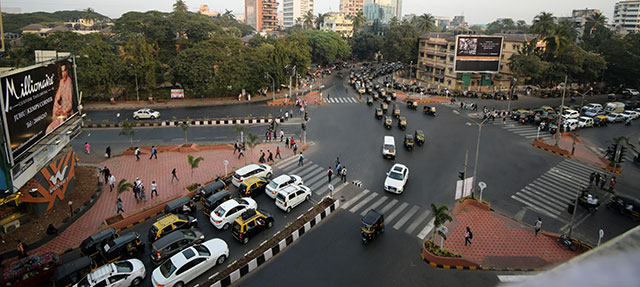In 2020, Mumbai was second in terms of congestion in a list of 100 cities from around the world. This is after Mumbai has spent close to $10 billion USD in the last twenty years widening roads, building flyovers, elevated roads and sealinks. So why has this investment not tackled the challenge of congestion? Or maybe that's the wrong question - is congestion the right challenge to solve for?
There is ample evidence that building more roads does not solve congestion. In fact, the opposite is true. There is lots of scientific evidence that more roads actually encourage more people to drive. Additionally, the traffic keeps adding to our already polluted cities. In Mumbai, pollution kills 500 people a year. Thousands more suffer from severe traffic injuries, and millions suffer lifestyle diseases due to lack of adequate physical activities, like walking and cycling.
 |
Let's look at how Mumbaikars travel. Based on the city's own data, 42 per cent of the people walk - to work, to places to education, and to many other places they need to get to. Twenty three per cent take the train, 12 per cent take the bus. Only three per cent travel by car, and we are focusing all our investments, energy, to build roads for this three per cent. It's not only the congestion or the deaths, the additional vehicles also lead to move greenhouse gases. In Mumbai, 24 per cent of greenhouse gas emissions are from transport.
Today we are in a climate crisis. The most recent report of the Inter-governmental Panel on Climate Change warns that somewhere between 2030 and 2040, we'll reach a stage where the average global temperatures will be 1.5 degrees higher than they were in the year 2000. Today, we have already covered 1 degree out of that. And people in cities are already feeling it. The Arabian Sea has had 10 cyclones since 2019. This part of the North Indian Ocean did not get many cyclones in the last 100 years. Scientists have evidence to attribute this rise in cyclone activity to a rise in temperature in the Arabian Sea on account of climate change.
So it is imperative for us to act now. We need to reduce greenhouse emissions in our cities. Our urban areas contribute 75 per cent of emissions globally, and urban transport provides a great opportunity to reduce them.
We need to stop building more roads to solve congestion. We need to stop building roads that by design prioritise cars. In cities, the majority of the people walk or use public transport. At nearly every location there are more people on foot than in cars. I challenge you to stop at any public location in your city and count the number of people on foot, or in cars. And you will see that there are more of the former than the latter almost everywhere.
That's why we need to build 'streets for people'. We don't need roads for cars, we need streets for people. We need to build them in such a way that they prioritise people by design. With good design, we can change roads for cars into streets for people, provide adequate space for people to walk and stop, build a street that communicates where and how they can cross a street, reduce the distances people have to cross at a time, reduce conflicts between people crossing and vehicles. And the hardest but most important - eliminate all on-street parking.
This does not require much additional funds. With clever design changes, we at the World Resources Institute have been able to demonstrate how to create substantially more space for walking and cycling. We have created streets for people, right here in Mumbai. We have been able to show metrics on improvement in terms of safety, and better flow of traffic by reducing conflicts. We can even test these solutions first with temporary materials. Cities around the world are realising this, and are changing.
Take the example of Paris. It has always been a walkable city. But now it is prioritising cycling. The new Mayor wants to transform the city into the world's cycling capital. The city has committed more than 150 million euros with the aim of doubling the kilometers of bicycle lanes. And with more people walking and cycling, the city doesn't need as much parking, and the spaces for this are being reduced by as much as 50 per cent across the city. Major arterials like Champs-Élysées are being turned into pedestrian-priority streets, allocating more than 50 per cent space to walking.
We've taken small steps in Indian cities to build streets for people. Mumbai has transformed closed to 50 junctions, and is soon going to launch an initiative to transform 450 km of streets. Delhi is pedestrianising places like Karol Bagh and Chandi Chowk. On 4 October, the government announced a commitment to make 540 km of streets friendly to pedestrians. Bangalore is developing an ambitious cycling plan. A pop-up cycling lane was initiated during the pandemic.
 HP Junction in Bandra, Mumbai is used by 70,000 vehicles and 50,000 pedestrians each day. It was redesigned expanding sidewalks, adding protected medians and islands, and streamlining traffic lanes.
HP Junction in Bandra, Mumbai is used by 70,000 vehicles and 50,000 pedestrians each day. It was redesigned expanding sidewalks, adding protected medians and islands, and streamlining traffic lanes.
But we need to be much, much more ambitious in our action across the country. This is the decisive decade to fight climate change. This is also the opportunity to humanise our urban places. Our cities need to raise their ambition. Others around the world have shown that with good leadership, in less than five years, we can transform our cities. We need to start today. We need to convince ourselves and our city leaders to design 'streets for people'.























